Violence against horses in everyday life
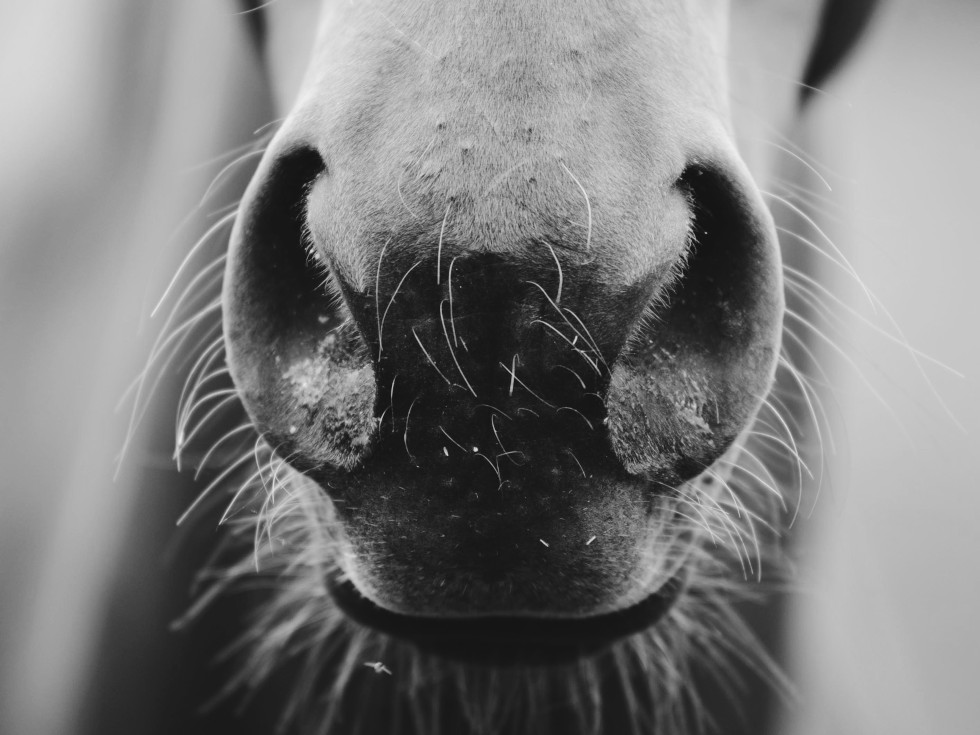
1. What is violence and what isn’t?
According to the Oxford dictionary definition, violence is “behavior involving physical force intended to hurt, damage, or kill someone or something“. Violence is described as ruthlessly applied power and wrongful action.
Rough, furious behavior on my part is only justified in absolutely exceptional cases, namely when it comes to avoiding danger (e.g. horse walks through a busy street, stopping a bleeding wound, horse attacks another living being).
2. Types of Violence
In this post, I separate violence into four different types:
A. Verbal violence
B. Physical violence
C. Psychological violence
D. Violence through bad horse husbandry
A. Verbal violence
Language is our preferred way of expression. Words can motivate and make you laugh, but they can also hurt and intimidate. With words we can persuade ourselves and others in the truest sense of the word and maybe even make a prophecy according to the self-fulfilling prophecy. Certain horse types, breeds, genders or even colors are quickly pigeonholed into made up categories.
“She is bitchy”, “Typical mare/stallion”, “He’s just testing you”, “You need to prove to them who’s boss”!
Have you heard such sentences or maybe you’ve talked like that about a horse yourself. Or your dog. Or a fellow human being.
By saying things like that we deny their feelings or impose feelings on them. We might use those words as quick explanations for a certain behavior of a horse. I get it, venting can provide a release in the short term.
The “bitchy chestnut mare” or the “stubborn stallion” are not just gender clichés, but often simply unfair titles. A lack of knowledge and a lack of training experience often lead to misinterpretations, which are expressed by people in the most harmless, but nevertheless unfair sense with the words mentioned above.
Another type of verbal abuse is denial of feelings. Even the French philosopher René Descartes (1596-1650) spread the thesis that animals are machines and therefore soulless. Aristoteles also believed that animals only existed for the sake of humans.
I hope you are way ahead of these two gentlemen and came across this article because you care about animal welfare.
“It’s just a horse, it doesn’t feel anything”, “Don’t exaggerate, they’re animals”, “Don’t humanize horses”, are all sentences that deny a horse’s sensitivity.
Assumptions like these can pave the way for physical violence.
Those who speak disparagingly of their animal instead of lovingly trying to understand their motives, and who do not believe that animals can feel both physical and emotional pain, will put less effort into seeking animal friendly training ways. Eventually they might hesitate less to physically punish a horse from time to time.
Imagine a kid yelling and kicking and the parents saying, “You’re just a little kid freaking out and acting up. Your feelings mean less.”
Unthinkable, right?
We humans have the ability to put our feelings into words. Horses don’t have that. And even if they cannot understand the meaning of our words, they can understand our intonation and sense our energy. The volume also plays a major role. No living being, including me, likes to be yelled at.
What can I do:
- Watch my own language (keep a tally if I catch or am caught insulting my horse)
- Find two positive thoughts for each negative one
- Write down what I love about my pet (and about myself)
- Increase your awareness of verbal violence (pay attention to the attributes people give to animals, e.g. on social media, TV, podcasts, horse magazines) and find alternative words
- Work more often in silence with my horse
- Carefully point others to their way of speaking and together practice a nicer form of expression
B. Physical violence
Although certain forms of horse management may also fall under physical violence, I would like to make a distinction for the sake of clarity and first write about physical violence through training methods and aids.
The most blatant violence against horses occurs through brute force such as hitting, kicking and yanking at the rope. Even in a layman, watching such behavior causes discomfort.
But in my opinion, more subtle means also fall under physical violence.
Let’s revisit the definition: “behavior involving physical force intended to hurt, damage, or kill someone or something” (Source: Oxford dictionary). A tight, poorly adjusted saddle, auxiliary reins, sacking, flooding, join up, breath-restricting tack, kicks with and without spurs, hyperflexion, aggressive body language (even if unintentional), whip and crop lashes are just examples for physical violence.
Even a horse that is lunged in a small circle, without having necessary muscles and balance, experiences psychological and physical violence. Aside from the extreme strain on tendons, ligaments, and joints, fast lunging in a small volte causes a lot of mental stress. Imagine you are just learning to ride a bike or skate and you have to make the tightest circles possible at high speed. Additionally, somebody pulls you inwards and holds you tight. It would cause constant struggle not to fall.
Most horses react violently only when they don’t understand what we’re asking them to do. When they are overwhelmed, or rushed during the learning process. Using more tack, more auxiliary reins, more force and pressure is certainly not the answer. We need to find the root of the problem first.
Institutionalized violence through associations, performance tests and training dogmas are other areas in which written rules often justify wrong actions.
There are also breed- and mission-specific uses of physical violence:
- Chemicals and Hoof Boots on Tennessee Walking Horses to enforce impressive gaits
- Serreta abuse among Spanish Horses
- Poling of jumping horses
- Hyperflexion in dressage horses
- Hitting (to teach rearing), using a lunge line (for compliment and lying down) when teaching circus tricks
- tying the head up in boxes for western pleasure horses for hours
- whipping racehorses
- Doping through drugs and ointments
- Flank strap (=bucking strap) on rodeo horses
- Auxiliary reins and brutal lunging of schoolmasters before riding lessons
- Excessive demands on trail horses
- Ignorance and poor training preparation in trail and endurance horses
- Malnutrition, poor equipment and excessive demand of carriage horses (see recent deaths in New York, tourist carriage horses in Charleston, South Caroline, horses as a means of transport in eastern countries)
This list can certainly be continued indefinitely, but at this point it should be enough to get a feeling.
What can I do:
- Prepare my horse patiently and in small steps
- Find the cause of a problem
- See defiance as an expression of a horse’s distress
- Use appropriate and fitting equipment
- Act proactively with the horse (set it up for success)
- Record myself and work on my body language and aids
- Study positive reinforcement
C. Psychological violence
Psychological violence is the use of emotional, often invisible, violence such as threats and scaring. In my opinion a technique called Join up falls under the category of psychological abuse (chasing a horse in a round pen until licking and chewing are observed, followed by pressure release and a so called voluntarily join), extreme desensitization by tying plastic strings or tarps to a horse, and flooding (inundation with stimuli). Beware that distress caused by this type of violence is often harder to recognize.
An interesting anecdote about Join up: It is claimed here that horses gain trust by being forced to run away from us (I find the idea paradoxical). The “trust” is supposedly proven by the fact that if you take the pressure off, the horse would join and follow the human. An interesting experiment has shown that horses will even turn to and follow a remote-controlled car when one performs a join up. How big is a horse’s trust in a car?
D. Violence through bad horse husbandry
This type of violence can go undetected for a long time, especially in private horse facilities where there is little surveillance.
People are not always aware of existing violence. Before judging anybody, a conversation should always be sought. Financial, health problems or family fates can all contribute to the fact that, for example, the medical care of a horse can no longer be provided. Horses whose hooves are neglected and are therefore restricted in their movement (vital for a predator, obesity and malnutrition, isolation, housing in small stables, no freedom of movement or daylight (sounds like a prison inmate, right?) and improper herd inclusion fall into the realm of violence through bad horse management.
What can I do:
- Improve horse husbandry
- Regular health checks
- Sufficient roughage, water and shelter
- Contact to other horses
- Enough pastures to run and forage
- Learn how to interpret horse body language
3. Consequences of Violence
No matter what kind of violence is used on the horse, the consequences are devastating and depending on the extent, they leave deep scars – physical and mental.
Constant stress with associated high hormone levels, auto-aggressive behavior (windsucking, weaving, hitting legs, biting) or aggression towards horses and people, illnesses and even death can result.
I’m convinced that your own soul won’t get away scot-free either.
Brutalization and blunting can occur, towards an animal, but perhaps also towards other people. People who become violent often lose touch with nature, have difficulty reflecting and withdraw or attack when they are confronted by fellow human beings. Some then hide their “methods” and train secretly, while others sell their “quick method” astraining success and pass on their aggression to inexperienced riders.
People who are aware of their wrongdoing and still cannot act differently can anonymously seek help from hotlines or professional online support.
4. Motives and explanations for violence
Justifications of those who use violence and reasons for violence should be distinguished here.
justifications
- dominance theory
Very often violent handling of the horse is justified by claiming a dominance issue “The horse is dominant”. The horse wants to scratch itself? “Don’t let it, that’s a dominance gesture!” The horse won’t bridle? “The horse is so dominant.” The horse bucks? “It’s dominant”… This list goes on and on.
The dominance theory has now been refuted.
Horses are also brutal towards each other
Brutal treatment of horses is often justified by the fact that horses are not squeamish towards each other. I recommend Mark Lubetzki’s books, in which he shows that kicking and biting horses are not an everyday thing in herds. There are very few actual fights.Most fights will take place when a stallion wants to steal mares from another stallion. It takes knowledge to create functioning herds. Often there is not enough space for too many horses, too few feeding places and too few exits in paddock trails. Herd members come and go, each time causing trouble in the community.
Toddlers in the sandbox also start hitting each other when they want the shovel from the others. Is that an argument that we are allowed to beat up children? No!
A horse has to work
Yes, horses need a solid basic education. They are not allowed to decide if and when they walk onto a street. For a horse to thrive in our world, it needs to be guided, vet treated, put on a horse trailer, and more. But I choose to teach the horse all this in a friendly manner (see tips at the end of the article).
Additional reasons:
- Longing for success
- Fear of “failure”, gossip by other stable members, social contempt
- Helplessness
- A feeling of having to deliver and only being a good trainer if problems get solved quickly
- Time and money, pressure from the owners and the social environment (“I can only afford to pay a trainer for one month”)
- Overwork, stress level too high, no adequate outlet (sport, meditation)
- Bad mentors (Children are often taught in riding lessons that something works like this and is done like this, and even later the instructions of the trainer or riding instructor are often not reflected, but followed blindly)
- Horses rarely fight back at the first acts of violence (slapping the chest with a rope, smacking the mouth, kicking the stomach), so doing such things can become a habit and normalized
- experience violence themselves
5. How do I react if I witness violence?
A.Observe violence in others
The eternal question: Do I say something or do I keep quiet?
Should I get involved? If yes, how?
When you feel safe to take action and speak up on behalf of abused animals, lead by example.
Ask questions, offer your help, or offer to help finding an expert. Avoid personal attacks, practice nonviolent communication, show alternative behavior. And if none of that helps or you feel unsafe to speak up, report the cause to a veterinary office or the police. Gather information about place, people, time, date, take photos, have witnesses.
click here to report animal abuse
click here to report animal abuse
You can also contact state-specific institutions that are listed online.
My attitude: Silence is neglected help for the weak!
B .Observing violence in myself
How do I deal with it, if I myself was or am violent towards living beings? Shame and guilt are troubling emotions to experience. It is all the more important to perceive them as such and to seek help accordingly. Talking to a non-horse owner can make it easier to admit your mistakes. It is advisable to express what one is feeling in I-messages or to write it down.
Nobody expects us to always have done or do everything perfectly. And many of us have certainly not been introduced to the world of horses in a particularly sensitive way. Remember your first introduction to horses: Fascinating, strong beings, maybe a bit unattainable, their sweet scent, your feelings when stroking their fur. We need to evoke these moments to forget the cruelty and rawness of so many children’s riding lessons. Because that wasn’t what we wanted when we were kids. We need to rediscover a sense of wonder towards these majestic animals. We need to be willing to learn from them, rather than constantly trying to teach them.
Because everything starts with a feeling. When compassion guides us, violence no longer stands a chance.
6. Positive outlook
Violence happens daily against supposedly weaker ones. Against children, animals, women, minorities and all those who deviate from the so-called “norm”. All the more reason to get involved, to stand up for yourself and to help others. It’s my duty to support horses. They have given me so much in life and taught me plenty about myself. I wasn’t always fair either and I continuously need to reflect on my behavior. I don’t want to turn away when injustice happens. I don’t want to point my finger at others and fight a computer war.
What I want is to offer alternatives so that violence no longer needs to be an option.
I want horse owners who have enough knowledge to train in a horse-friendly way. I want trainers who are given the time they need to train horses, organizations that courageously break away from outdated structures. I want stables that can survive economically without compromising horse welfare. I want children who can trust their intuition and defend themselves against yelling riding instructors. I like people who -in spite of René Descartes’ claims – show the world how worthy it is to protect the souls of animals!
And finally I would like to appeal to you to let your heart speak, to take the time to look at your animal with love.
That’s what makes me thrive.
Below I’ve put together a few solutions that might be of some help in the future.
- Counseling center
- Horse license
- Regular compulsory courses for children and adults regarding handling and training
- Factual and mannered exchange on social media instead of getting personal and attacking
- Reformation of old structures
- When mistakes happen, share ideas and find new ways
- De-objectifying horses: how horses are treated in movies (brutal pulling of the reins in western films, no equestrianism in the Olympic Games, stricter controls at horse fairs and shows)
- Concern hotline for pet owners
- More control in private stables
- Financial support for the veterinary office by the state
- More courage from veterinarians, stable operators, processing and renewal of the FEI (International Federation for Equestrian Sports)
- Willingness to invest more money and time in training/correction etc.
- As a horse owners demand to be included in the training from the beginning
- Educational, pro-horse TV shows (The Horse Whisperer is not what I mean)
- We need more support and less shows that tell us one training session will cure all problems.
- Unannounced controls (stables, shows, riding lessons, training, breeding associations)
- Camera surveillance at tournaments, training, riding lessons
- Insurance changes (bitless riding and still insured)
- More transparency in horse training, as a trainer make no secret of your training success, invite people to watch how you work
- Don’t think you have to be an expert for everything, but also don’t hand your horse blindly to a trainer, instead be part of the training and have everything explained to you
- Time
- Knowledge (experts, self-learning, help, criticism, further education)
- patience
- Willingness to deviate from pre-established paths and respond individually to the animal
- Be understanding and understandable (no animal knows what we have in mind)
- baby steps attitude
- Give breaks
- Give praise
- Good nature
- Kind heartedness
- Focus on what works to create a positive training atmosphere
Reading recommendations
- Literature and homepage of Marlitt Wendt. The behavioral biologist Marlitt Wendt has written many very good books. Their homepage is also a treasure trove: https://rplus.click/
My personal favorite book by Marlitt Wendt is “Understanding Behaviour, Emotions and Intelligence
- Even if I’m a fan of positive reinforcement myself, there are also trainers who follow the principle of horsemanship, which I appreciate very much and I consider “pro horse”. These include e.g. B. Jenny Wild, Peer Claßen and Andrea and Markus Eschbach.
- The Tellington Method: I got into groundwork through Linda Tellington-Jones over 35 years ago. I still adore this woman today and am very grateful for what she brought to the world through the groundwork and body work she developed for horses (nevertheless I don’t recommend some of her early equipment, such as lead chains and the LTJ bit).
Horsespeak by Sharon Wilsie https://sharonwilsie.com/learn-horse-speak/
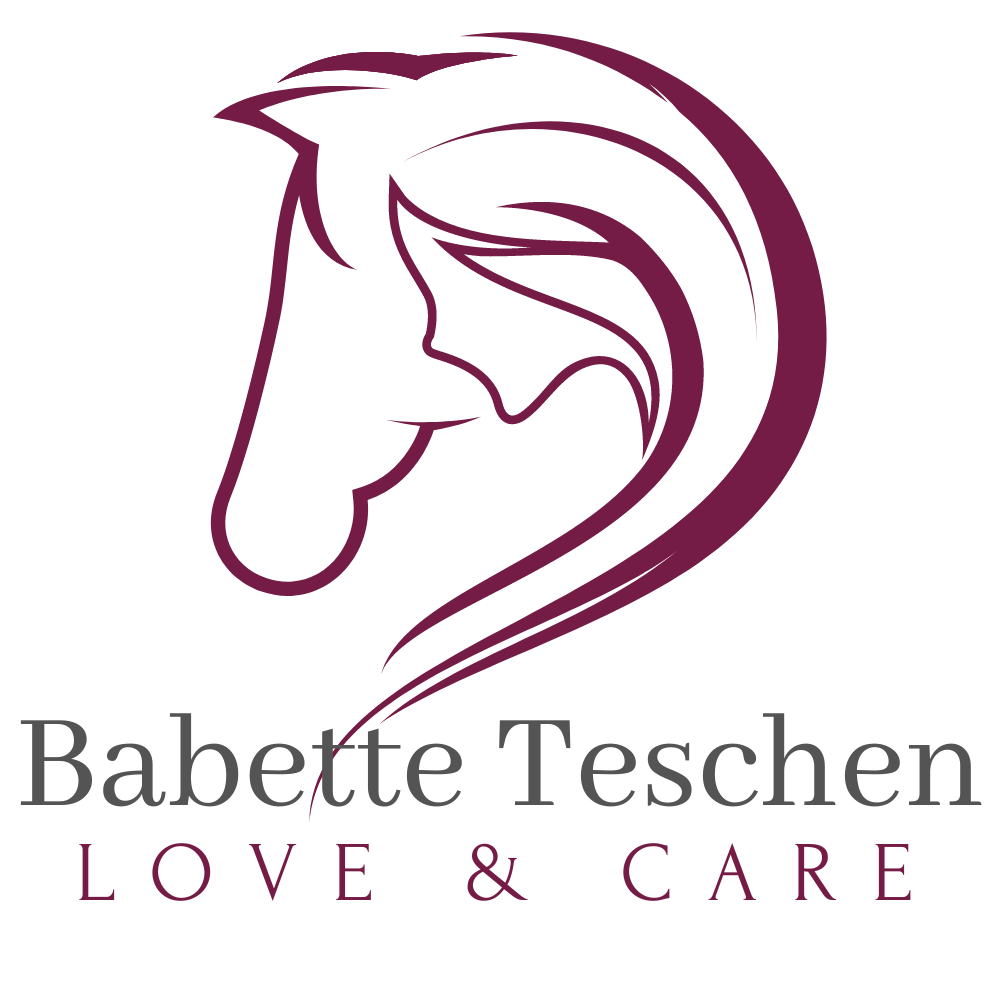
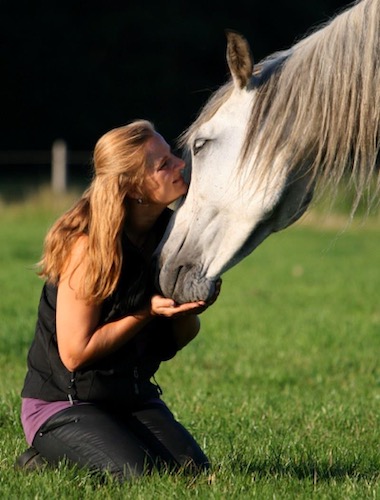

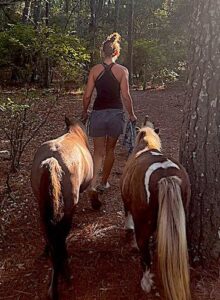
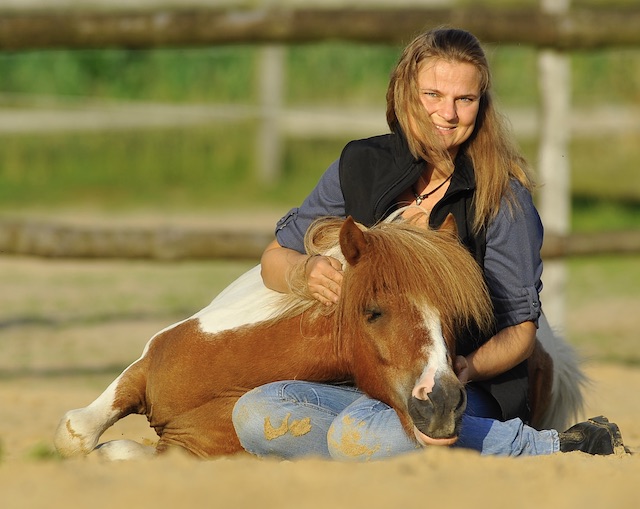
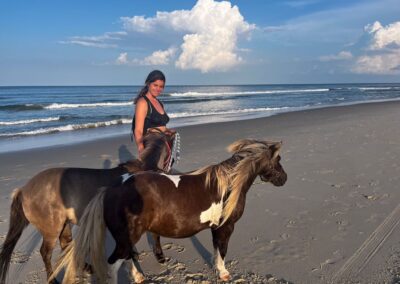
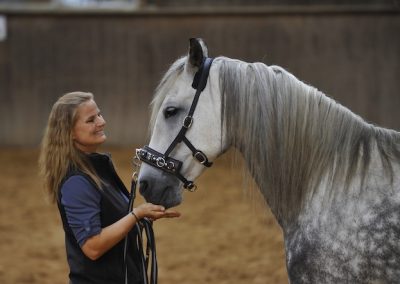
0 Comments